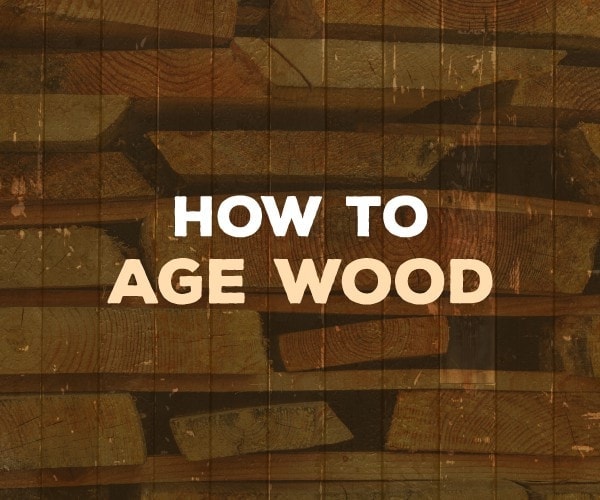Over time, wood develops a gorgeous patina that looks beautiful for use in all sorts of projects. But, unless you have a cache of lumber aging in your backyard, it can be difficult to find properly weathered wood for the job. Fortunately, you can fake it with surprisingly authentic results.
Today, we’ll teach you how to age wood so you can bring that sought-after weathered look to your next project, without waiting years for nature to weather the wood for you.
What You’ll Need
This is a job you’ll be able to tackle with virtually no tools. You may even be able to get away with not having all the materials below. Here’s a basic list of the things you’ll need to learn how to age wood.
0000 Steel Wool
- White vinegar
- Mason jar
- Paintbrush
- Painter’s tape
- Scrap wood
Keep in mind that you can also achieve a beautifully aged look with store-bought stains, as well. Most major paint and stain brands also make rustic stains designed to give a weathered and aged look to wood. Today, we’re going to cover a DIY method that’s cheaper and arguably more authentic looking.
Step I: Making Iron Vinegar
To get the aged look you’re hoping to achieve; you’ll need to make a solution known as iron vinegar. Making iron vinegar is about as easy as putting together a pitcher of iced tea.
First, take a baseball-sized piece of steel wool and place it in an empty mason jar (any old jar with a lid will do just fine.) Fill the jar with white vinegar and let it sit.
The vinegar will break down the steel wool, and in turn, it creates a finish that will quickly oxidize your wood, creating that sought-after weathered effect.
Feel free to experiment with your iron vinegar mixture. The longer you leave the steel wool in, the darker and more profound the effect will be when you brush it on your wood. I use 0000 steel wool for this because it breaks down more quickly than more coarse steel wool.
Step II: Working With Pine? This Step is Sure to be Your Cup of Tea
Iron vinegar does a great job of weathering most lumber. But, if you’re working with pine, iron vinegar by itself won’t have a very profound effect. To bump up the rustic look when working with pine, you’ll need to brew some tea.
Tea contains tannic acid, which reacts with the iron vinegar to produce a darker and more dramatic effect. For most lumber, the tea isn’t necessary, and you can achieve the finish you’re looking for with iron vinegar alone. But, if you’re working with pine, you’ll need a coat of tea on the wood to produce the effect you’re looking for.
Boil 8 ounces of water and add to it two black tea bags. Set your tea to the side, as we’ll be using it shortly.
Step III: Testing Your Finish
Before you finish the wood you’ll be using for your project; it’s very helpful to make a test piece to see how the finish reacts with your wood.
First, make sure that the wood you’re using for your test piece is identical to the wood you’ll be using for your project.
Wrap a thick piece of painter’s tape around the scrap wood, close to the middle. You’re going to stain one side of the scrap wood and leave the other side bare for the sake of comparison.
If you’re working with pine, brush on the tea you made in step II, and allow the tea to dry.
Next, brush on your iron vinegar. Apply a generous, even coat of the solution, using a paintbrush. You’ll notice an immediate change in the color of the wood, and you should achieve the desired effect in about four hours or so.
For most projects, one coat will get you the look you want. But, feel free to add additional coats if you’d like a darker finish.
If you’re happy with the look of your scrap piece, move on to the good wood for your project. Otherwise, now is the perfect time to experiment. Try brushing the tea solution onto other types of lumber, apply multiple coats of iron vinegar, etc. Eventually, you’ll arrive at an ideal finish for your taste.
Step IV: Finishing the Wood
Once you’ve arrived at a finish you’re happy with on your test piece, all you have left to do is replicate that process on your good wood. Brush the finish on the same way you did on the test piece you were satisfied with. Allow it to dry, and you’re good to go!
Step V: Distressing the Wood (Optional)
If you’re looking to double down on your distressed finish, feel free to have a little extra fun once your finish has dried.
I usually take a tube sock and fill it with old nails and screws, tie a knot in the sock, and then beat the wood with it to give it some extra character. A few shots with a framing hammer or mallet won’t hurt, either.
The sky's the limit when it comes to the distressing process, feel free to get creative.
Final Word
Learning how to age wood is as easy as it is fun, and it can be a rewarding project that allows you to exercise your creativity. Best of all, you’ll only need a few simple supplies to get the job done. If you’re looking for some crafty ideas on how to use your new weathered wood, check out this blog.

